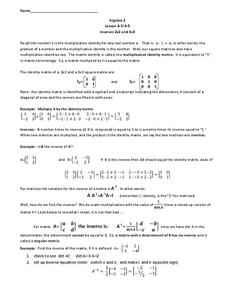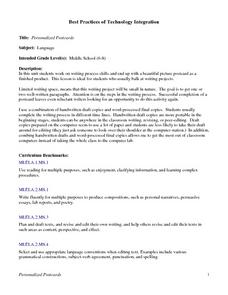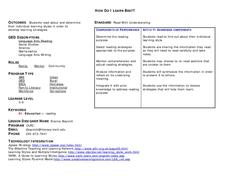Curated OER
A Nation Divided
Fifth graders participate in various activities related to the Civil War. In this Civil War lesson students understand the events and feelings of people during the Civil War by studying primary sources, journal writing, readings, viewing...
Curated OER
Ecology
In this ecology worksheet, students read information about ecology and the nine ecology subdivisions and answer comprehension questions. Students answer ten questions in this matching and fill in the blank worksheet.
Curated OER
Using News Broadcasts in Japan and the U.S as Cultural Lenses
Young scholars view archives of news broadcasts in order to create a context of cultural understanding. They compare and contrast the news broadcasts in Japan and the United States.
Curated OER
Boombox Classroom: Music and Language
In this music and speech worksheet, students find similarities between language and music. Students also tell about their own language. Students also may write the 7 music letters.
Curated OER
Lizards
Fourth graders recall lizards from the text and report their important traits. The teacher adds the information to the map. They watch the map expand while it organizes all of the lizards and their characteristics.
Curated OER
Create a Computer Story
Second graders will create their own story and read it aloud. For this literacy/technology lesson, 2nd graders use computer software to create their own story, which is read back to them while they write it. Afterward, the student should...
Curated OER
Famous People Research Project
Fourth graders research a famous person in Michigan history. They will use at least three different resources including technology to conduct their research. They then will use various forms of technology to create individual research...
Curated OER
Matrices
In this Algebra II worksheet, 11th graders determine if matrices are inverses, multiply matrices, and solve matrix equations. The three page worksheet contains explanation of topic, worked examples, and five practice...
Curated OER
Here's an Instant Activity for March 7, 2005
Fifth graders complete a spelling activity for homographs. In this spelling instructional activity, 5th graders complete a crossword puzzle using homographs.
Curated OER
Instant Spelling Activity: Homographs
Students identify homographs. In this homograph lesson, students listen to a sentence that contains a homograph to identify the homograph. Students choose 16 homographs to put in a BINGO grid. Students write sentences...
Curated OER
Prime and Composite Numbers
Sixth graders identify prime and composite numbers and complete an activity problem. Given a 100 chart, they follow directions to create a prime number chart. In groups, 6th graders play a "Prime Take Away" activity to reinforce prime...
Curated OER
There Was An Old Lady...
First graders read "There Was An Old Lady Who Swallowed a Fly" and use Kid Pix to identify characters from the story. In this character identification lesson, 1st graders first hear several versions of the classic tale, and then locate...
Curated OER
Personalized Postcards
Students create and send postcards to friends and family members. Using actual photographs, they write a rough draft and final draft of a paragraph and print it out to glue onto a postcard template to mail to their friend or family member.
Curated OER
Homographs and Homophones
Fourth graders complete a crossword puzzle. In this homophones and homographs lesson, 4th graders define homographs and look at examples. Students contrast homographs and homophones. Students complete a worksheet where they fill in a...
Curated OER
Proofreading - Spelling, Capitalization, Grammar and Punctuation
Fourth graders practice proofreading a passage. In this proofreading lesson, 4th graders complete a worksheet by reading a passage and circling twelve errors. They proofread for errors in spelling, capitalization, grammar, and punctuation.
Curated OER
Assuming Responsibility
Sixth graders explore the concept of responsibility. In this character education instructional activity, 6th graders discuss the various types of responsibilities they have. Students create their own definition of responsibility based on...
Curated OER
Bunnicula
Students create a dictionary of vocabulary after reading a story. Individually, they create a story web making sure to include all of the basic story elements. They also create a timeline and write a book report of all important events.
Curated OER
Welcome to Venice
Learners read the opening scene of the play, The Merchant of Venice without receiving any background information. They analyze and discuss the relationships between the six characters, and determine the social status of the characters.
Curated OER
Beyond Louisiana
Eleventh graders examine the challenges that faced United States as a new nation. In this American History lesson, 11th graders study the chronology of events leading up to the expedition of Lewis and Clark. Students organize...
Curated OER
Responses to Discrimination During the Civil Rights Period
Students examine the effects of discrimination. In this American Civil Rights Movement lesson plan, students participate in a classroom activity that requires them to personally feel the effects of discrimination. Students then explore...
Curated OER
Extract Your Own DNA from Cheek Cells
Students observe their own DNA. For this DNA lesson, students learn the simple method of DNA extraction and explain why DNA extraction is important to scientists.
Curated OER
What About Us? Women in the Civil War
Students research the role of women in the Civil War. In this Civil War unit, students research the role women played during the war. This unit includes eight different activities including vocabulary, writing prompts and a literature...
Curated OER
Solving Equations
In this Algebra II worksheet, 11th graders use the properties of equality to solve multi-step equations in one variable. The tow page worksheet contains explanation, guided examples, and fifteen practice problems. Answers are...
Curated OER
How Do I Learn Best?
Students discover their learning styles. In this language arts lesson, students read about the various learning styles. Students determine their learning style and discuss how they can use this knowledge.

























